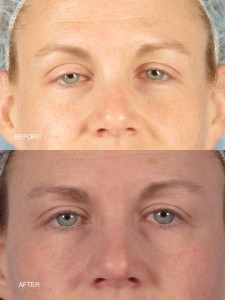What is eyelid ptosis?
A droopy upper eyelid, defined as an eyelid margin (the lower edge of the eyelid near the eyelashes) that resides in a vertically low position.
How is eyelid ptosis treated?
Determination of cause of droopy eyelid
Before planning the correction, the cause of eyelid ptosis is investigated. The most common cause is age-related stretching of the eyelid lifting tendon (levator aponeurosis). A poorly developed muscle, present from birth is a less common cause, as are some more rare conditions including tumors and aneurysms.
The cause of the droopy eyelid and the function of the eyelid muscle will guide the treatment plan.
Types of droopy eyelid surgery
For the most common cause of eyelid ptosis (muscle tendon separation), there are two main treatment approaches:
1. External approach
An incision is made in the upper eyelid crease and the eyelid lifting muscle tendon (levator aponeurosis) is identified and shortened or advanced and fastened to the structural eyelid plate (tarsus) to raise the eyelid. Stitches are placed in a manner that recreates the natural eyelid curvature.
2. Internal approach
An internal incision is made and a section of the mucous membrane eyelid lining (conjunctiva) and the lesser eyelid lifting muscle (Mueller’s muscle) is removed and the free edges are reattached with sutures. This technique shortens the back layers of the eyelid (with some effect on the main eyelid lifting muscle tendon (levator aponeurosis).
Congenital droopy eyelid treatment
In cases where the droopy eyelid is present from birth, if there is poor muscle function, a brow sling is used to lift the eyelid. A material forms a sling (e.g. silicone, banked fascia, autogenous fascia) and connects the eyelid plate (tarsus) to the eyebrow. Incisions are made in the eyelid crease and at the upper edge of the eyebrow hair. The sling material is threaded through the deep tissue of the eyebrow and under the skin and muscle of the eyelid. Raising the eyebrow will then cause the eyelid to lift.
If the eyelid lifting muscle has adequate function, the external approach procedure can be performed with a moderate or large amount of muscle tendon advancement to lift the eyelid.
Follow-up care
Swelling and/or bruising is expect for the first one to two weeks. Stitches are removed in approximately one week. With the eyelid in a raised position, dryness of the eye surface can occur. This is treated with lubrication drops and ointment.
Procedure risks
Inability to completely close the eyelids can occur and this is more common with the eyelid sling procedure. Eyelid closure is monitored in the recovery period and in many cases normal closure function returns.
Overcorrection (eyelid too high) or undercorrection (eyelid not high enough), or eyelid asymmetry can be present. Because the eyelids work as a pair, elevation of one eyelid can lead to drooping of the opposite side. In some cases, revision surgery or secondary lifting surgery of the other eyelid is required.
The contour of the upper eyelid may have areas of peaking or sagging. These contour issues can relate to post-surgical swelling or due to placement of stitches.
Raised incision edges on the inside of the eyelid or stitches that pass through the inner surface of the eyelid can lead to irritation and eye surface abrasion.
Related procedures
Eyelid ptosis repair is often performed at the same time as upper blepharoplasty if excess eyelid skin is present with a low-positioned eyelid.

